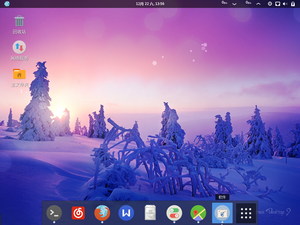Red Flag Linux
 | |
 Screenshot of Red Flag Linux Desktop 9.0 | |
| Developer | Red Flag Software |
|---|---|
| OS family | Linux (Unix-like) |
| Working state | Current |
| Source model | Open source |
| Initial release | 1.0 August 1999[1] |
| Latest release | 10.0[2] / January 2020 |
| Kernel type | Monolithic (Linux kernel) |
| Default user interface | KDE |
| License | Various |
| Official website | www |
Red Flag Linux (Chinese: 红旗Linux) is a Linux distribution developed by Red Flag Software. As of 2009[update], the executive president of Red Flag Software is Jia Dong (贾栋).

Beside specialised solutions, Red Flag Linux had the following products:
- Red Flag Asianux Server 8.0
- Red Flag HA Cluster 7.0
- Red Flag Desktop 10 (红旗Linux桌面操作系统v10.0)
- Red Flag Desktop 11 (红旗Linux桌面操作系统v11.0)
The internal structure of Red Flag Linux is very similar to Red Hat Linux, using a similar installer.
History
[edit]Red Flag Linux first appeared in August 1999, when it was created by the Institute of Software Research at the Chinese Academy of Sciences.[3][failed verification] Financial help came from government-owned Shanghai NewMargin Venture Capital. In March 2001, Bloomberg News reported that CCIDNET Investment, a venture capital arm of the Ministry of Industry and Information Technology, had become Red Flag's second largest shareholder.[citation needed]
During a brief standoff with Microsoft in January 2000, in a year-long series of increasing tensions believed to have been tied to Microsoft's perceived mismanagement of its Microsoft Venus venture, Chinese government ministries were ordered to uninstall Windows 2000 from their computers in favor of Red Flag Linux.[4]
In January 2006, Red Flag Linux joined the Open Source Development Labs.[5]
An Equation Group leak from 2017 included tools that targeted Red Flag Linux.[6]
2014 Closure/Restructuring
[edit]On 10 February 2014, Red Flag Software terminated all employment contracts and closed down. The direct cause of the closure was cited as being the failure of the Chinese Academy of Sciences' Software Research Institute to pay a 40 million yuan subsidy. The institute cited Red Flag's failure to complete a specific project, and general mismanagement, as reasons for not paying the subsidy.[7]
According to a research manager with IDC in Beijing, its downfall resulted from a lack of brand awareness and sustained investments, coupled with the rise of rivals.[7]
Nanchang Internet cafes
[edit]As of 3 December 2008, it has been reported that Internet cafes in Nanchang, since November 2008, have been required to install the Red Flag Linux as a replacement for pirated versions of the popular Microsoft Windows operating system, or switch to legitimate copies of Microsoft Windows. Radio Free Asia (which is funded by the U.S. government[8]) claimed that Chinese internet cafes were being required to switch to Red Flag Linux even if they were using genuine copies of the Windows OS.[9][10] This system is provided with a non-expiring support contract at the cost of 5000 yuan (~ US$850, February 2014) for all machines in the cafe.
An official spokesperson for Red Flag Linux clarified by stating that the announcement were targeted to the server-side and not the gaming-intensive (and therefore Windows demanding) client-side computers, and that in the original announcement, Microsoft Windows and Red Flag Linux were simply recommended platforms as they have been tested by the Bureau of Culture.[11][12]
See also
[edit]- Asianux
- China Software Industry Association
- Software industry in China
- Ubuntu Kylin
- Astra Linux – a similar project by the Russian government
- Unity Operating System
- Canaima (operating system) – a similar project by the Venezuelan computer manufacturer VIT, C.A. and Chinese information technology company Inspur
- GendBuntu – a similar project used by Gendarmerie in France
- LiMux – a similar project of the city council of Munich
- Nova (operating system) – a similar project by the Cuban government
- Red Star OS – a similar project by the North Korean government
References
[edit]- ^ Doc Searls (30 January 2002). "Raising the Red Flag". Linux Journal. Retrieved 20 February 2021.
- ^ "Red Flag Desktop Linux红旗Linux桌面 10". www.chinaredflag.cn. Retrieved 20 February 2021.
- ^ Shankland, Stephen (24 May 2007). "Chinese software company to tailor OpenOffice". CNet. Archived from the original on 13 April 2016. Retrieved 22 November 2012.
- ^ IDG (23 February 2000). "Microsoft in China: Clash of titans". CNN. Archived from the original on 22 October 2008. Retrieved 5 May 2009.
- ^ Paul, Ryan (14 January 2006). "Red Flag Linux distributor joins OSDL". Ars Technica. Retrieved 21 November 2012.
- ^ "In slap at Trump, Shadow Brokers release NSA EquationGroup files". Ars Technica. Retrieved 11 April 2017.
- ^ a b "Chinese software pioneer Red Flag bites the dust". 14 February 2014.
- ^ Jim Mann (30 September 1996). "After 5 Years of Political Wrangling, Radio Free Asia Becomes a Reality". Los Angeles Times. Retrieved 1 April 2013.
The new broadcast station, created by Congress to serve as an Asian counterpart to Radio Free Europe, started modestly and quietly Sunday, with a half-hour news broadcast to China.
- ^ "China Internet cafes switching to Chinese OS". The Sydney Morning Herald. 3 December 2008.
- ^ "Chinese ordered to stop using pirate software - the INQUIRER". Archived from the original on 6 December 2008. Retrieved 3 December 2008.
{{cite web}}: CS1 maint: unfit URL (link) - ^ "Chinese City Requires Net Cafes to Use Legitimate Software". 2 December 2008.
- ^ 外媒报道断章取义 南昌网吧软件正版化被恶意渲染 (in Chinese). 5 January 2009. Archived from the original on 19 October 2015. Retrieved 19 January 2009.
External links
[edit]- Official website
- Red Flag Linux at DistroWatch
- "Red Flag, China's home-grown Linux distribution, is a good start". NewsForge. Archived from the original on 27 January 2008.
- Raising the Red Flag (Linux Journal)
- Harvard Business School study of Red Flag Software
